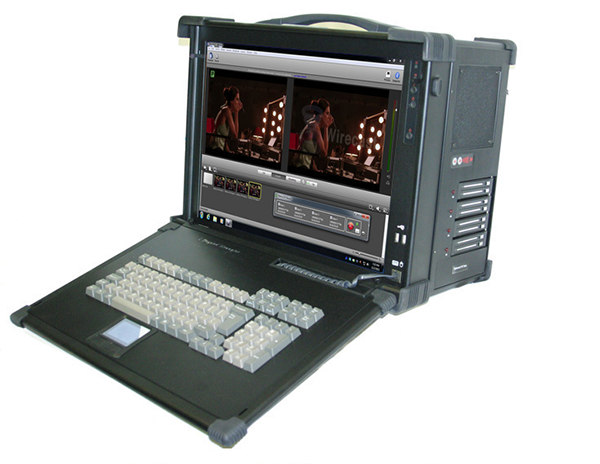Review: Producing Webcasts with Telestream Wirecast and the Matrox VS4
Running Telestream Wirecast with the Matrox VS4, a powerful, well-integrated capture card, handling most of the input/encoding/previewing load, yields impressive results that catapulte Wirecast into the TriCaster/Livestream Studio class of product when it comes to responsiveness.
The Test Systems
1 Beyond provided two test systems for our review: the StreamMachine and the StreamMachine Pro. The Stream Machine is a small-form-factor computer with a 4-core (8 with HTT) 3.5 GHz Intel Core i7-3770X CPU with 8 GB of RAM running 640-bit Windows 7 and using embedded Intel graphics from the motherboard.
The unit is about 5”x13”x9” and weighs 8 pounds, and can be driven with a monitor and keyboard or with an iPad (which I didn’t test).
The StreamMachine Pro is the sexy sister of the duo, a self-contained unit with a 17” monitor and keyboard with an embedded mousepad, and a “watch your back” weight of 38 pounds. This unit ships with a 6-core 3.5 GHz Intel Core i7-3970X CPU with 8 GB of RAM running 64-bit Windows 7, though with an NVIDIA GeForce GT610 graphics card.

Figure 3. The StreamMachine Pro was 38 pounds of streaming and mixing power.
For the record, the StreamMachine is priced at $4,495 while the StreamMachine Pro is $8,495. The most affordable turnkey starts @ $3,599.
My Tests
To test both systems, I set up two cameras with a PowerPoint source from a third and two DDR-based videos. I created a bug and a title, and broadcast to Livestream while storing a copy of the presentation to disk and an ISO recording of both input cameras. The VS4’s auto-sensing made it easy to connect my cameras to the system; a nice changes from teh trial and error that accompanies all my efforts to connect Blackmagic Design capture components.
On the StreamMachine Pro, CPU utilization averaged between 27%-32% during the production, while the number jumped to around 65-70% on the slower StreamMachine. The 70% number on the StreamMachine is close to the red line; if you plan a four-camera production with extensive use of remote inputs and DDR while storing multiple ISO and archive versions, I’d choose a faster system. On both machines, preview was at full frame rate, with impressive responsiveness throughout.

Figure 4. My Wirecast presentation.
You can watch the presentation that I put together here, though there are some caveats. First, the audio is a bit muffled, courtesy of the coat over the lav mike. Second, I hosed the transitions a bit, and should have gone to a simple cut rather than the funky fade to black. Third, there’s a small glitch at 7:02, right after I access the Broadcast panel to review the available presets. Note that Wirecast warns you that checking this dialog could degrade results, and it did produce about a one-second glitch. In essence, all errors are mine, not the system’s, serving as a needed reminder that self-proclaimed master product reviewers don’t produce master webcasts every time out.
Related Articles
Any time you produce a webinar that's got PowerPoint and a talking-head video, it's helpful to present them in the same video frame. This tutorial explains how to composite these two sources in Telestream Wirecast.
Matrox VS4 not only sends video feeds to Wirecast for streaming, it simultaneously provides ISO recording of all the original video and audio feeds to disk, which is essential for high-quality post-event editing